![]()
![]()
![]()
Use LEFT and RIGHT arrow keys to navigate between flashcards;
Use UP and DOWN arrow keys to flip the card;
H to show hint;
A reads text to speech;
35 Cards in this Set
- Front
- Back
|
How does snow define an antigen?
|
any substance that binds specifically to an antibody or a T cell antigen receptor
|
|
|
What is an antibody?
It is synonymous with the term... They may be found where? |
a protein produced by B cells that binds specifically to an antigen
immunoglobulin (Ig) They can be on the surface of B cells or secreted as soluble proteins |
|
|
What is the TCR?
What is an MHC? |
T cell antigen Receptor
a complex of proteins on the surface of T cells that binds specifically to peptide antigens bound to an MHC: major histocompatibility complex protein on the surface of other cells |
|
|
And compare/contrast immunogen and antigen
|
An immunogen is a type of antigen that elicits an immune response.
|
|
|
What's the term for the site of an antigen that directly contacts the antigen-binding pocket of an antibody or T cell receptor?
What is a synonym for this. If you just took these and innoculated an animal with them, what would happen? |
Epitope
antigenic determinant Just the epitope part is not enough. It counts as an antigen, but would not elicit an immune response and is therefore not an immunogen. |
|
|
Another antigenic determinant/epitope... what does it need?
What clinical application has to do with all these? |
hapten
if physically, covalently attached to a larger carrier protein, it becomes an immunogen Vaccinations |
|
|
At what point in the life cycle are the B and T cells synthesizing their receptors?
Each ___ of B and T cells makes a unique receptor. |
During the maturation process before exposure of the cells to antigen.
clone |
|
|
Binding of antigen to cell surface receptors causes cell ___ and ___ into ___ cells and ___ cells.
|
proliferation and differentiation into memory cells and effector cells.
|
|
|
How are clones selected?
The different ones selected for during the lifetime of an individual determines the ___. |
The foreign antigens select just by being able to bind to that unique antigen.
Immune repertoire. We all have a unique but overlapping one depending on cells selected and put into memory and effector cells. |
|
|
Antibodies recognize ___ proteins on the ___ surface of ___.
Cell surface ___ is part of the B-cell receptor |

native macromolecules on the outer surfaces of pathogens
immunoglobulin |
|
|
T cell receptors recognize ___ antigens produced by _____
What is the outline of the steps that lead to this? |
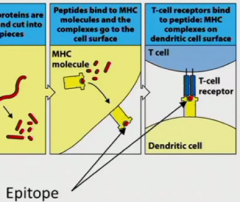
peptide antigens produced by degradation of proteins
dendritic cell takes up pathogen -> degrades it -> binds the peptides (epitopes) to MHC molecules and puts them on the surface |
|
|
What's the relationship between dendritic cells and antigen-presenting cells (APC)?
|
Dendritic cells are the most common kind of APC for naive T cells. There are other APC's though.
|
|
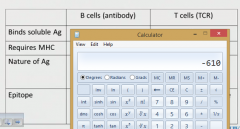
fill it out!
|
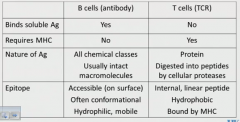
T cells see processed proteins associated with MHC. Protein.
B cells see soluble Ab. B cells can see CHO or DNA. Most often hydrophilic. |
|
|
What characteristics make antigens more immunogenic? 3x3
|
foreignness
high molecular weight chemical complexity so- biological, chemical, and physical properties of antigens changes immunogenicity |
|
|
Rank macro classes in highest to lowest immunogenicity.
|
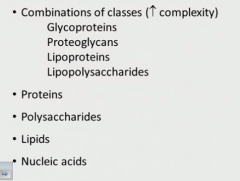
It kind of makes sense-- nucleic acids aren't nearly as interesting/unique in combos as proteins or CHO.
|
|
|
proteins are ____, that is they have multiple epitopes on a single protein molecule.
Each epitope is recognized by a different ___ of B cell, thus inducing a ___ response. The epitopes can comprise ___ or ___ peptides for different respective cell types |
multivalent
clone polyclonal linear or discontinuous; T cell and B cell |
|
|
In discontinuous epitopes, what is important in the process?
|
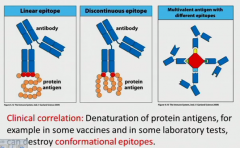
These are dependent on a conformation. So if the native protein gets denatured, the conformational epitope is destroyed and antibody will not recognize. So important for most B cells and doing vaccines, and if you're running gels or generally denaturing one.
|
|
|
What's a multivalent antigen? What's another name?
|
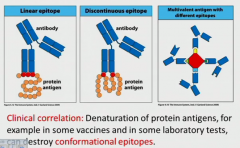
polyclonal
it can recognize different antibodies |
|
|
T/F T cells' antibodies look at linear epitopes, and B cells' antibodies look at discontinuous epitopes.
|
F
B cells can use linear and discontinuous epitopes, just mostly they use discontinous |
|
|
What is the main antigen type made for gram-positive bacteria?
|
peptidoglycan
|
|
|
For gram negative bacteria the major epitopes are derived from
|
lipopolysaccharides
|
|
|
for gram-positive, encapsulated bacteria the major epitopes are derived rom...
|
polysaccharide
|
|
|
Antigens on the outer surfaces of bacteria are ___ with ___ ___ epitopes which is key to understand Type 2 ___ Independent Antigens
|
multivalent with repetitive identical epitopes
Thymus |
|
|
What's a serotype?
|
Different bacteria have different serotypes. They see what antibodies bind to the antigens. The bacteria can be the same, like strep for pneumonia, but they'll have different serotypes.
|
|
|
How do serotypes play a role clinically?
|
If you are vaccinated against one serotype of a bacteria, and you end up in contact with a different one, the vaccination won't help you. So when you make a vaccine, you want to choose something common among all serotypes or include multiple serotypes- so I'm thinking HPV vaccines.
|
|
|
What are different types of viral antigens they can put in a vaccine?
|
Whole virus
recombinant viral protein (take genetic piece of virus and put in bacteria for them to make for us) viral peptide coupled to a carrier protein (the peptide isn't immunogenic so it's a hapten, put it on a carrier making a hapten carrier) |
|
|
If using whole virus as immunogen what is the antigen and what is the epitope?
|
protein antigen
peptide is linear or discontinuous |
|
|
If using recombinant viral protein as immunogen what is the antigen and what is the epitope?
|
protein antigen
peptide can be linear or discontinuous |
|
|
If using viral peptide coupled to a carrier protein as immunogen what is the antigen and what is the epitope?
|
peptide-carrier antigen
peptide is linear |
|
|
So for influenza virus: epitopes for antibodies are on the ___ of the virus particle while epitopes for ___ are primarily derived from internal viral proteins
Major types of influenza virus are designated ___ and ___ |
surface
T cells from internal viral proteins A and B |
|
|
What are the subtype influenza A defined by?
|
the sequences of the H and N glycoproteins.
There are 16 unique H subtypes and 9 unique N subtypes. So H1N1 makes more sense. |
|
|
What do the H and N stand for?
|
haemagglutinin
neuraminidase |
|
|
___ viruses tend to have a lot more mutations.
Why is this a problem? |
RNA
mutates faster than DNA. Less fidelity. You can develop antibodies just to have them quickly not work because of mutations in the hemagglutinin |
|
|
When the virus shuffles it's material after going through a bird.. that's called...
and it results in a ___ virus derived from different virus strains |
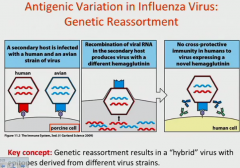
genetic reassortment and humans will not have protection against that virus
|
|
|
So why are there yearly flu vaccines?
What do we wish? |
New flu vaccines are made each year to match the currently prevalent strains- the H and N
They want to make a virus that will have broadly neutralizing antibodies that would target all H molecules, so one vaccine, and you never get it. Same thing for AIDS. It'd be pretty cool. |

